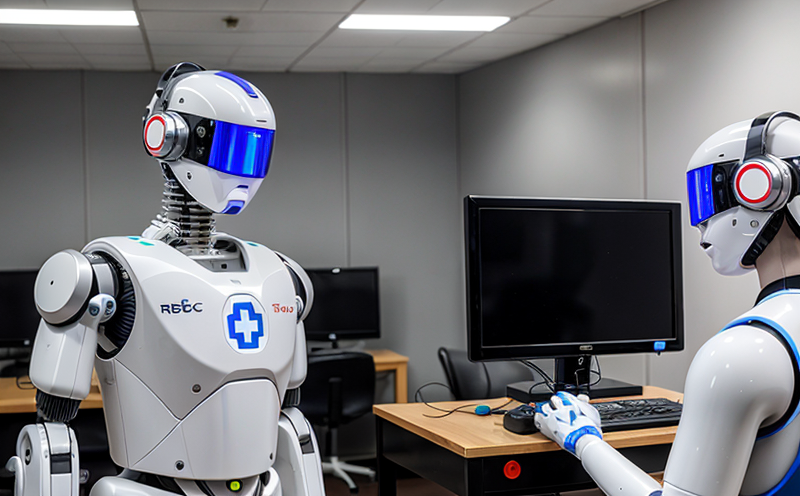ISO 10993-1 Biocompatibility Evaluation of Medical Robot Materials
The ISO 10993-1 biocompatibility evaluation is a crucial step in ensuring the safety and effectiveness of medical robots. This standard, part of the broader family of ISO 10993 standards, provides guidelines for assessing the biological compatibility of materials used in medical devices, including robotic systems.
The primary aim of this evaluation is to identify potential adverse effects that may arise from contact between a robot’s components and human tissues. This includes assessing the toxicity, irritation, sensitization, hemocompatibility, and other relevant parameters. The evaluation process involves several stages: material selection, extraction studies, in vitro testing, and clinical assessment.
For medical robots, this evaluation is especially important due to their direct interaction with patients during surgical procedures or therapeutic interventions. Ensuring the biocompatibility of these materials helps prevent adverse reactions that could compromise patient safety and efficacy of treatment.
The process begins by selecting appropriate test specimens from the chosen material. These specimens are then subjected to extraction studies, where they are exposed to physiological fluids such as blood, saline solution, or phosphate buffer solutions. The extracted substances are analyzed for their potential to cause adverse biological effects.
Following extraction, in vitro tests are conducted using cells and tissues to observe any harmful reactions. Common assays include cytotoxicity testing (CytA), genotoxicity testing (Ames test, Comet assay), and hemolysis assessment. These tests help determine whether the material can cause cell death, genetic damage, or interfere with normal blood function.
After these preliminary evaluations, clinical assessments may be necessary if there is a risk of significant adverse effects based on previous results. Clinical trials involve monitoring patients who have been exposed to the materials under evaluation for signs of toxicity or sensitization. This final step ensures that all risks are thoroughly assessed before the medical robot can be approved for use.
The ISO 10993-1 standard also emphasizes documentation and reporting, requiring detailed records of each stage of the biocompatibility evaluation process. This includes information on material selection, test protocols, results, and any conclusions drawn from these analyses. Proper documentation is essential not only for regulatory compliance but also for continuous improvement in future iterations of medical robots.
Understanding the intricacies of ISO 10993-1 biocompatibility evaluation is vital for quality managers, compliance officers, R&D engineers, and procurement personnel involved in developing or procuring medical robotics technology. It ensures that all components meet stringent safety standards before entering clinical use.
Applied Standards
The ISO 10993-1 biocompatibility evaluation standard is widely recognized and applied across the globe for assessing materials used in medical devices, including robotics. It aligns with other relevant international standards such as ASTM F713 (Standard Practice for Determining Hemocompatibility of Medical Devices) and EN ISO 10993-6:2018 (Guidelines on the Use of In Vitro Toxicity Testing Methods in Biocompatibility Assessment).
Compliance with these standards is essential to ensure that medical robots meet global regulatory requirements. The use of standardized protocols helps maintain consistency and comparability across different manufacturing locations and laboratories, facilitating smoother international trade and collaboration.
Scope and Methodology
| Stage | Description |
|---|---|
| Material Selection | Selecting appropriate test specimens from the chosen material for extraction studies. |
| Subjecting materials to physiological fluids such as blood, saline solution, or phosphate buffer solutions. | |
| In Vitro Testing | Conducting tests using cells and tissues to observe any harmful reactions. Common assays include Cytotoxicity (CytA), Genotoxicity (Ames test, Comet assay), and Hemolysis Assessment. |
| Clinical Assessments | Monitoring patients for signs of toxicity or sensitization if there is a risk of significant adverse effects based on previous results. |
Each stage of the biocompatibility evaluation process is critical in ensuring that medical robots comply with safety and efficacy standards. Extraction studies help identify potential leachable substances from materials, while in vitro tests assess whether these substances can cause harmful biological effects. Clinical assessments provide real-world data on patient interactions with the materials.
The comprehensive approach outlined by ISO 10993-1 ensures that all aspects of material safety are thoroughly evaluated before a medical robot can be deemed safe for clinical use. This standardized methodology promotes trust in both regulators and end-users, contributing to better healthcare outcomes worldwide.
Benefits
- Achieves Regulatory Compliance: Ensures that all materials used in medical robots meet stringent safety standards set by international regulatory bodies.
- Reduces Risks: Identifies potential adverse effects early in the development process, minimizing risks to patients during clinical use.
- Enhances Trust: Demonstrates commitment to patient safety and quality of care, building trust between healthcare providers and end-users.
- Simplifies International Trade: Standardized protocols facilitate smoother international trade by ensuring consistency across different manufacturing locations and laboratories.
- Fosters Continuous Improvement: Detailed documentation and reporting enable continuous evaluation and improvement of materials used in medical robots.
- Promotes Innovation: By providing a clear framework for evaluating material safety, ISO 10993-1 encourages innovation in developing new and safer medical robotic technologies.
The benefits of adhering to the ISO 10993-1 standard extend beyond compliance; they contribute significantly to enhancing patient safety and overall quality of care. By reducing risks associated with material interactions, fostering trust among stakeholders, simplifying international trade processes, promoting continuous improvement, encouraging innovation, and ultimately achieving regulatory approval, this standard plays a pivotal role in advancing medical robotics technology.





